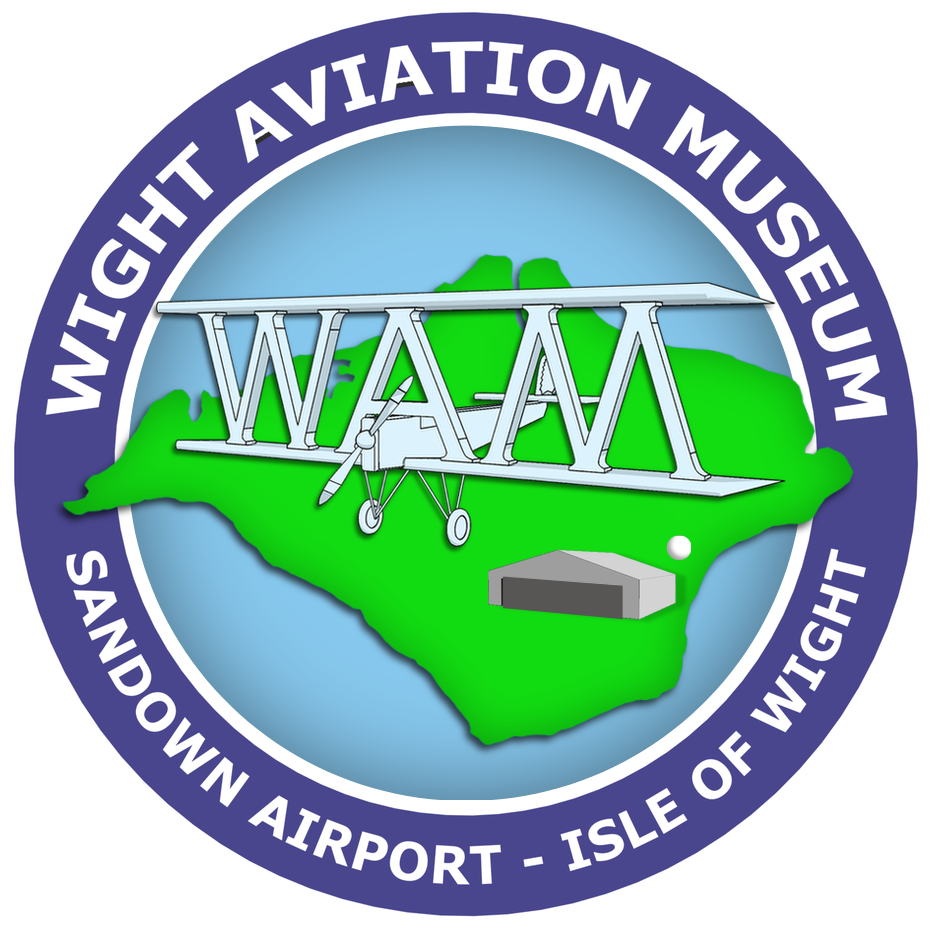Some of the incredible Aircraft built on the Isle of Wight over the last 120 years..
The Spartan – 1930’s
The Spartan bi-plane was designed and built in Somerton, Cowes in the early 1930’s. These 3 seater planes were extremely popular with the new generation of wealthy private pilots, allowing 2 passengers to be flown hundreds of miles for business and pleasure, all be it exposed to the elements.
The wings were designed to fold back easily, in order to be stored in a shed rather than requiring a dedicated hangar, 25 of the 3 seater Spartans were produced in total in the early 1930’s.
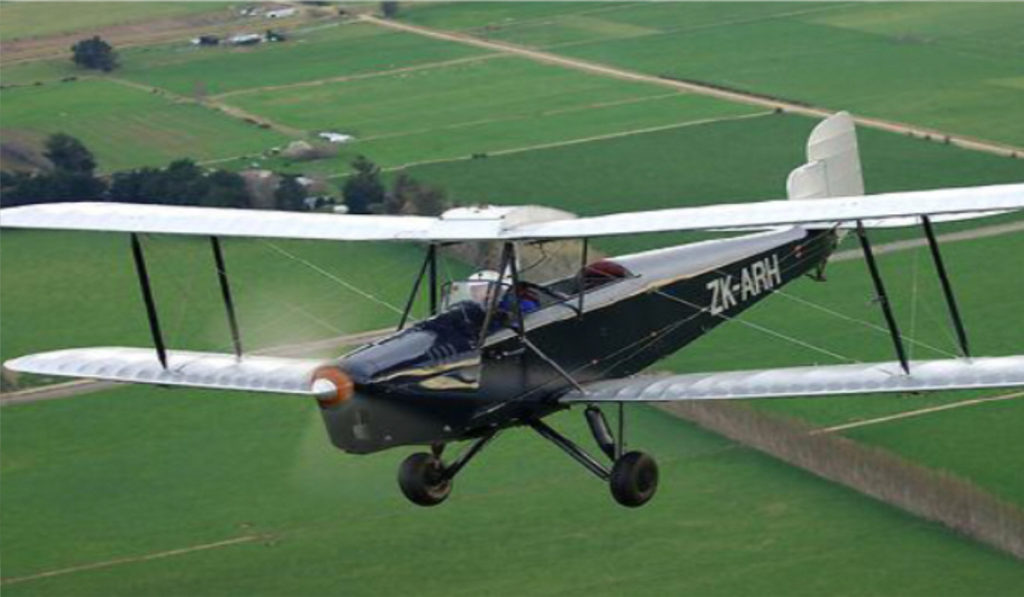
Owner Rod Hall Zones has lovingly restored the aircraft.
Rod would like the aircraft to become part of the Wight Aviation Museums collection and we hope to secure enough funding in future to achieve this.
Specifications (Three Seater Mk II)
- Length: 26 ft 3 in (8.0 m)
- Wingspan: 28 ft 10 in (8.79 m)
- Height: 9 ft 8 in (2.95 m)
- Wing area: 240 ft² (22 m²)
- Empty weight: 1,030 lb (468 kg)
- Max. takeoff weight: 1,680 lb (764 kg)
- Powerplant: 1 × Cirrus Hermes I or II inline piston, 120 hp (90 kW)
Performance:
- Maximum speed: 93 knots (107 mph, 172 km/h)
- Range: 226 nm (260 miles, 419 km)
- Rate of climb: 750 ft/min (3.8 m/s)
Saunders-Roe SR.A/1 – 1940’s
The Saunders-Roe SR./A.1 was a prototype flying boat fighter aircraft designed and built by British seaplane manufacturer Saunders-Roe. It was the first jet-propelled water-based aircraft in the world.
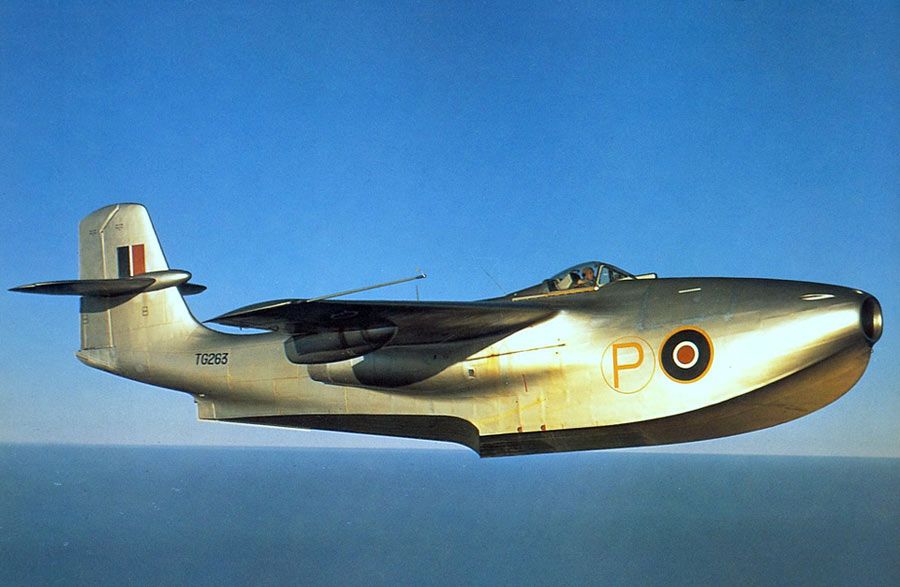
The concept behind the SR./A.1 originated during the Second World War as a reaction to Japan’s successful use of military floatplanes and the emergence of the turbojet engine. Saunders-Roe presented an initial proposal of their jet-powered seaplane concept, then designated SR.44, to the Air Ministry during mid-1943.
In April 1944, the Ministry issued Specification E.6/44 for the type and supported its development with a contract for three prototypes. Development was protracted by Saunders-Roes’ work on other projects, the war having ended prior to any of the prototypes being completed.
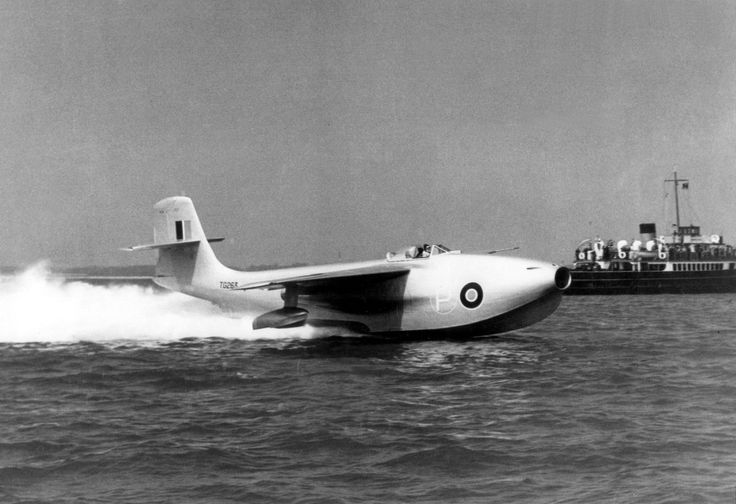
On 16 July 1947, the first prototype made its maiden flight. The SR./A.1 was evaluated by the Royal Air Force (RAF), who concluded that the design was incapable of matching up to the performance of land-based designs. Despite interest from foreign governments, including the United States, no orders for the SR./A.1 materialised.
As such, it never entered volume production or saw service with any operators. While interest in the SR./A.1 programme was briefly revived following the start of the Korean War, the aircraft was considered to be obsolete by that point and was again rejected.
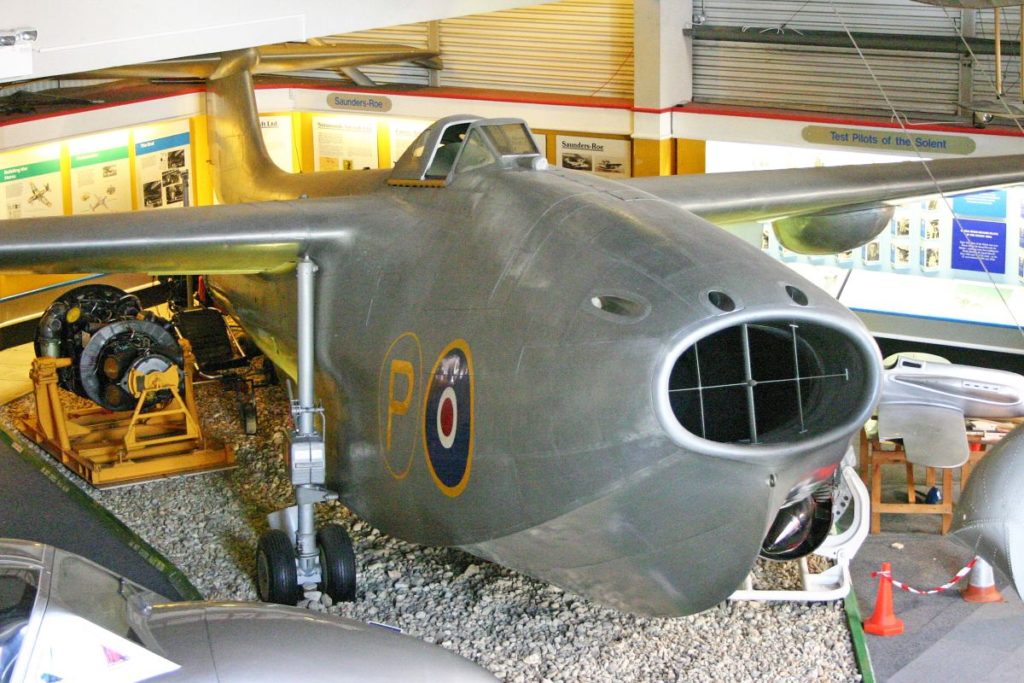
Specification (SR/A.1)
A Metropolitan-Vickers F.2/Beryl turbojet engine
- Crew: 1
- Length: 50 ft 0 in (15.24 m)
- Wingspan: 46 ft 0 in (14.02 m)
- Height: 16 ft 9 in (5.11 m)
- Wing area: 415 sq ft (38.6 m2)
- Empty weight: 11,262 lb (5,108 kg)
- Gross weight: 16,000 lb (7,257 kg)
- Max takeoff weight: 19,033 lb (8,633 kg) max. overload weight with slipper tanks
- Fuel capacity: 424 imp gal (509 US gal; 1,930 L) internal fuel, with provision for two 149 imp gal (179 US gal; 680 L) slipper tanks
- Powerplant: 2 × Metropolitan-Vickers Beryl MVB.2 turbojets, 3,850 lbf (17.1 kN) thrust each
Performance:
- Maximum speed: 512 mph (824 km/h, 445 kn)
- Endurance: 1 hr 48 min
- Service ceiling: 48,000 ft (15,000 m)
Armament:
- Guns: 4x 20 mm Hispano Mk 5
- Rockets: 8× rockets
- Bombs: 2x 1000 lb (455 kg) bombs
The SR-53 Jet Fighter – 1950’s
The SR-53 Jet Fighter was designed and built by Saunders Roe at the famous Columbine Works in East Cowes.
The Saunders-Roe SR.53 was a British prototype interceptor aircraft of mixed jet and rocket propulsion developed for the Royal Air Force (RAF) by Saunders-Roe in the early 1950s.
The SR.53 would have been used as an interceptor aircraft, using its rocket propulsion to rapidly climb and approach incoming hostile bombers at high speeds and following it’s attack run, the aircraft would be able to return to its base by making use of the secondary jet propulsion instead.
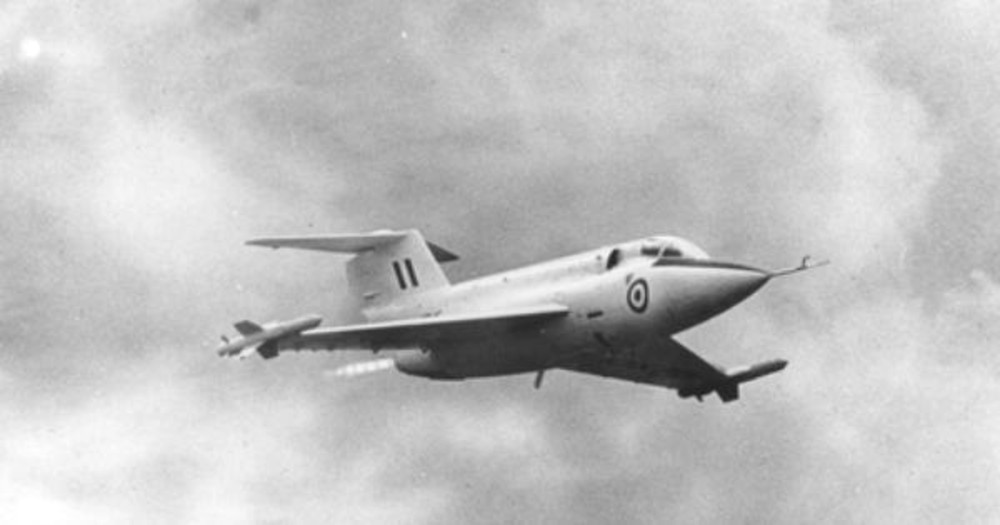
Although the SR.53 proved to have promising performance during test flights, the requirement for such an aircraft had been overtaken by rapid advances in surface-to-air missile technology, leading to reconsideration of the aircraft’s purpose. In July 1960, the development program was formally cancelled, by which time a total of 56 test flights had been performed.
A pair of prototype SR.53 aircraft had been completed and used during flight tests. One of these was destroyed during one such test flight in June 1958. The other, the first prototype, survived and was preserved and is currently on public display at the Royal Air Force Museum Cosford.
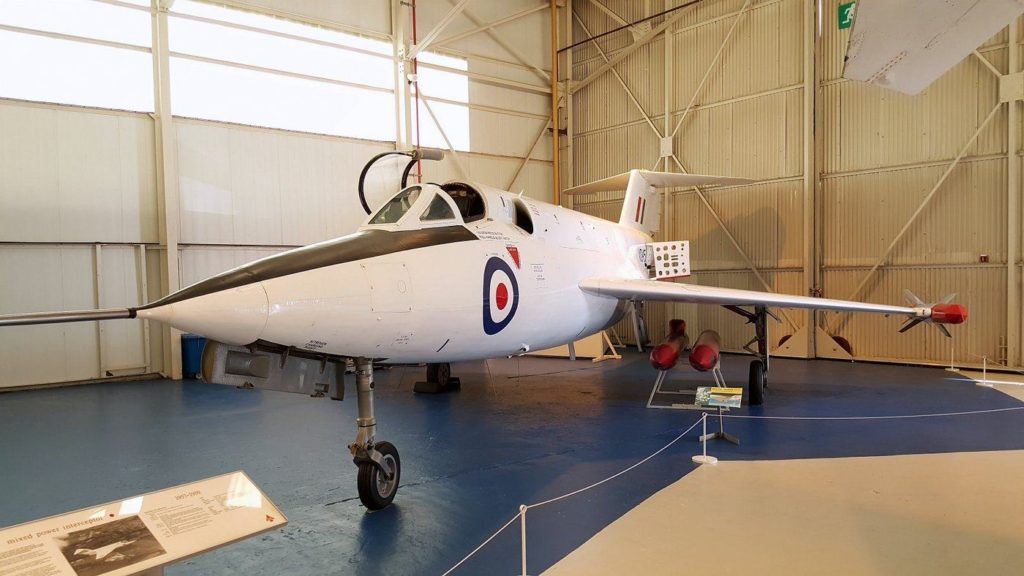
Specifications:
- Crew: 1
- Length: 45 ft 0 in (13.72 m)
- Wingspan: 25 ft 1.5 in (7.658 m)
- Height: 10 ft 10 in (3.30 m)
- Wing area: 274 sq ft (25.5 m2)
- Airfoil: RAE 102[34]
- Empty weight: 7,400 lb (3,357 kg)
- Gross weight: 18,400 lb (8,346 kg)
- Powerplant: × Armstrong Siddeley ASV.8 Viper 8 turbojet engine, 1,640 lbf (7.3 kN) thrust
- Powerplant: 1 × de Havilland Spectre liquid-fuelled rocket engine, 8,000 lbf (36 kN) thrust.
Performance:
- Maximum speed: Mach 2.2
- Endurance: 7 minutes at full power (jet + rocket)
- Service ceiling: 67,000 ft (20,000 m) [35]
- Maximum speed: Mach 2.2 at 52,800 ft (16,093 m) (M1.34 achieved)
- Rate of climb: 52,800 ft/min (268 m/s)
- Time to altitude: 50,000 ft (15,240 m) in 2 minutes 12 seconds
- Wing loading: 67.2 lb/sq ft (328 kg/m2)
- Thrust/weight: 0.52
Armament:
- Missiles: 2 × de Havilland Firestreak infra-red guided missiles
Britten Norman Islander
The Britten-Norman BN-2 Islander is a British light utility aircraft and regional airliner designed and originally manufactured by Britten-Norman from the mid 1960’s.
It Still in production today and the Islander is one of the best-selling commercial aircraft types produced in Europe, with over 750 still in service with commercial operators around the world. The aircraft is also used by the British Army and police forces in the United Kingdom and is a light transport with over 30 military aviation operators around the world.
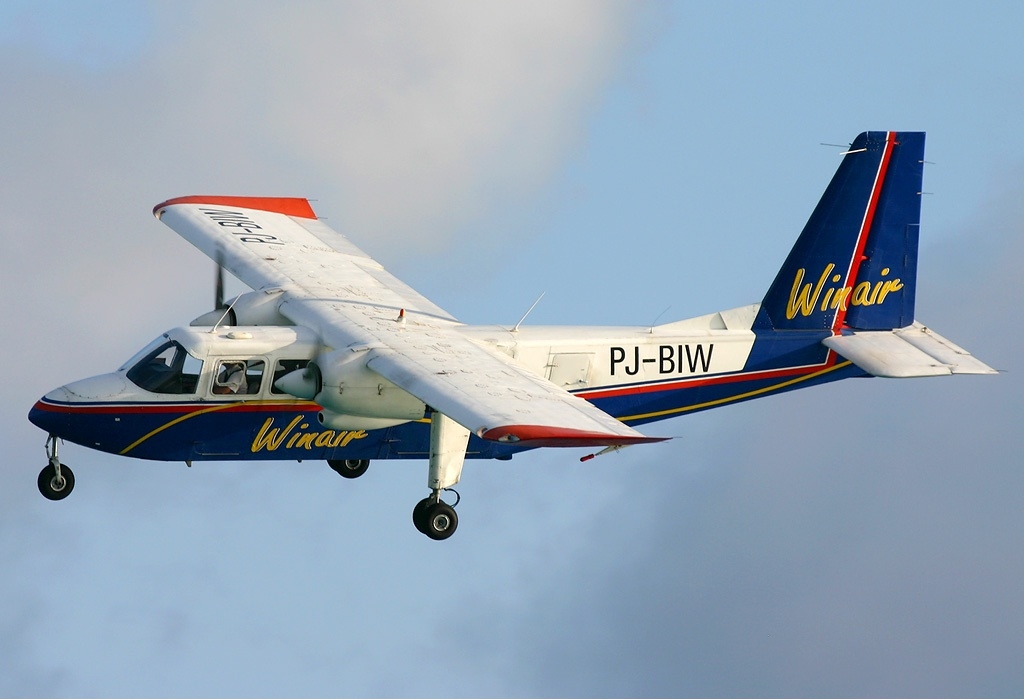
Initially the aircraft were manufactured at Britten-Norman’s factory in Bembridge, Isle of Wight, UK but due to increased demand additional capacity was added in Romania, but after the company ran into cash flow problems in the early 1970’s the company was acquired by Fairey Aviation and production of the Islanders and it’s larger sibling the Trislander aircraft, was only continued in Romania to reduce production costs.
The completed fuselages were then shipped to Avions Fairey works in Belgium for finishing, before being flown to the UK for flight certification. The Islander has now been in production for over 50 years.
In 1953 Britten-Norman was formed by John Britten and Desmond Norman for the purpose of converting and operating agricultural aircraft, amongst other vehicles such as the Cushioncraft hovercraft. In 1963, the firm initiated development work upon what would become the Islander, having sensed a demand for a simple and inexpensive twin-piston engine aircraft. John and Desmond had seen the rapid growth of the commuter airline sector and concluded that capacity was of a higher value to these operators than either range or cruising speed, thus the Islander emphasized payload over either of these attributes.
